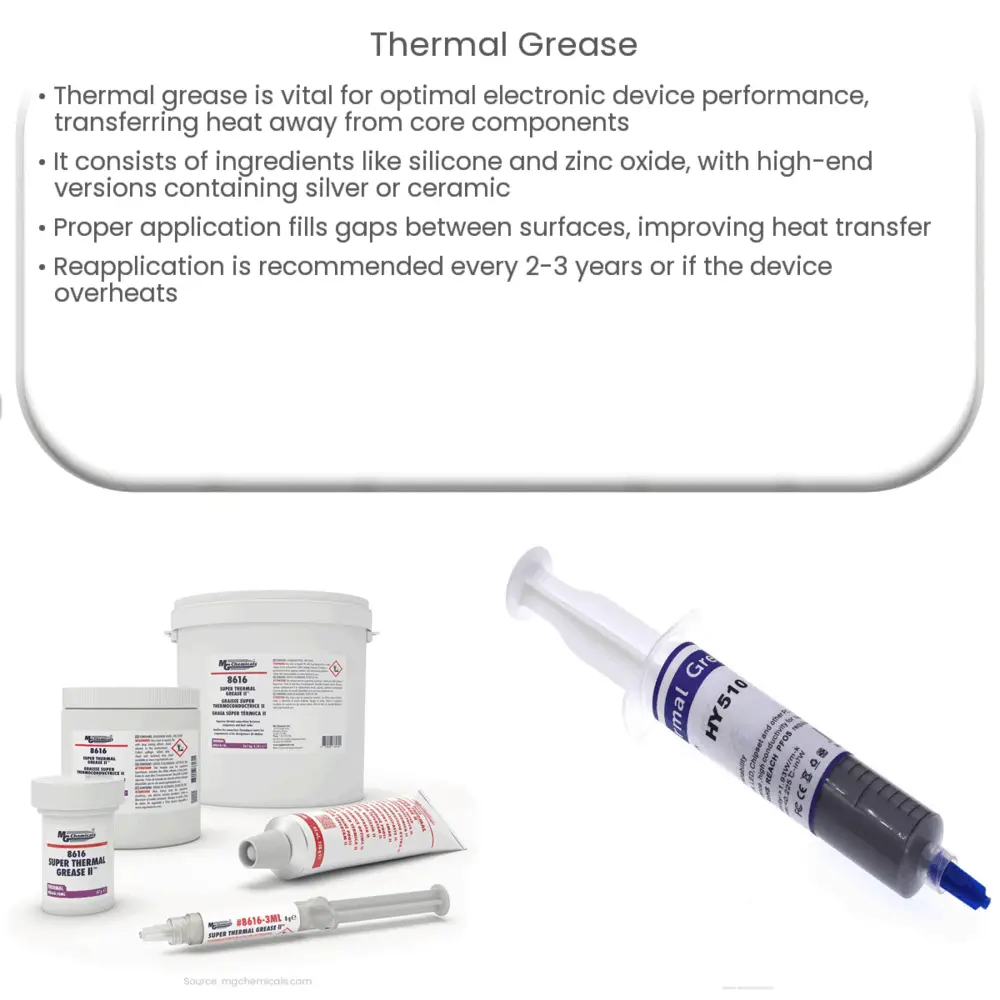Explore the importance of thermal grease in electronics, its composition, application, and tips for optimal usage and device longevity.

Introduction to Thermal Grease
Thermal grease, also known as thermal paste, thermal compound, heat sink compound, or heat paste, is an essential component in maintaining optimal performance in modern electronics. This specially designed substance plays a critical role in transferring heat away from the device’s core components, thus ensuring the system’s functionality and longevity.
Composition and Function of Thermal Grease
Thermal grease is a type of thermally conductive compound. It comprises a mixture of various ingredients, which may vary according to the manufacturer and purpose of use. However, it generally contains a blend of silicone, zinc oxide, and other metal oxides. Higher-end variants may also contain silver or ceramic for enhanced thermal conductivity.
The main function of thermal grease is to fill air gaps or microscopic irregularities that occur between two surfaces – typically a CPU or GPU and a heat sink. These irregularities can lead to inefficient heat dissipation due to air’s poor thermal conductivity. By applying a layer of thermal grease, these gaps are filled, allowing for more effective heat transfer and thereby maintaining the device’s performance and durability.
Application of Thermal Grease
The application of thermal grease is a fairly straightforward process but must be done with care to avoid possible damage to the device.
-
Initially, the surfaces of both the component (such as a CPU or GPU) and the heat sink must be cleaned thoroughly to remove any dust or old thermal paste.
-
The thermal grease is then applied to the center of the component. It’s crucial to apply just enough to cover the entire surface when the heat sink is pressed onto it, but not so much that it spills over the edges.
-
The heat sink is then carefully placed and secured onto the component. The pressure will spread the thermal paste evenly across the surface, filling in all the tiny gaps and irregularities.
It’s important to note that thermal grease isn’t a permanent solution. Over time, it can dry out and lose its effectiveness, requiring reapplication to maintain optimal thermal conductivity.
When to Reapply Thermal Grease
The need for reapplication of thermal grease varies based on the usage of the device and the quality of the paste. However, a good rule of thumb is to reapply thermal paste every 2-3 years for a heavily used device, or whenever the device begins to overheat frequently. If the device is disassembled for any reason, it’s a good practice to reapply the thermal paste to ensure optimal thermal conductivity.
Tips for Choosing and Using Thermal Grease
-
Not all thermal greases are created equal. Consider the specific needs of your device and research the best types of thermal grease for your specific application. High-quality thermal paste may cost more, but can provide better performance and longevity.
-
Applying too much thermal grease can be as detrimental as applying too little. An excessive amount of thermal grease can spill over and lead to electrical conductivity issues in your device. A pea-sized amount is typically sufficient for most CPUs.
-
Use tools, such as a plastic spatula or card, to spread the thermal grease evenly over the surface of the CPU or GPU. This ensures that the paste covers the entire surface, increasing the efficiency of heat transfer.
-
Handle thermal grease with care. Some types of thermal grease can be hazardous if they come into contact with your skin or eyes. Always follow the manufacturer’s safety instructions when handling and applying thermal grease.
Conclusion
In conclusion, thermal grease plays an indispensable role in the functionality and durability of modern electronic devices. By efficiently transferring heat away from critical components, thermal grease helps maintain optimal performance levels and extend the lifespan of devices. Whether you’re building a new PC, upgrading a GPU, or performing routine maintenance, the application of thermal grease is a crucial step that should not be overlooked. By understanding the composition, function, application, and reapplication of thermal grease, users can better manage their devices’ thermal performance and contribute to their longevity.

